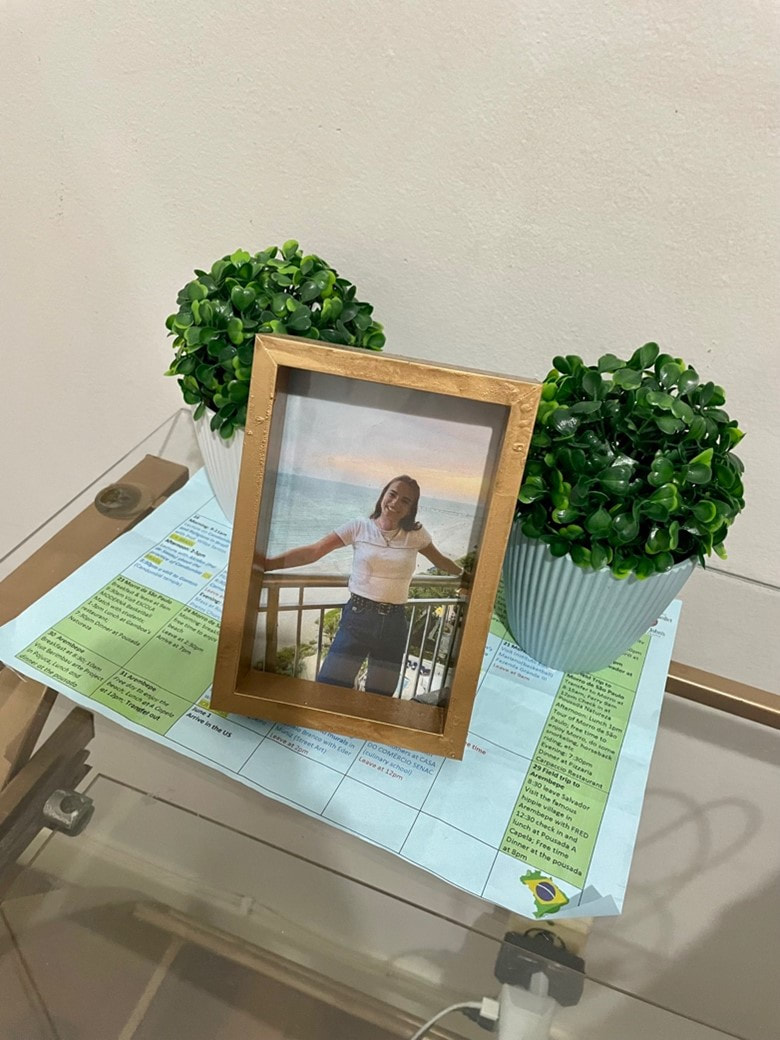|
By Lizbet Martinez and Fabian Venegas Ramos On the day we are writing this, we have been in Bahia for 12 days. Through our educational program, we have learned about various topics related to race, gender, and inequality in Brazil including the education system, religion, and expansive history lessons. Some of our favorite lectures and experiences, however, have been centered on music and dance. These two mediums are more than just entertainment, but cultural ways of being, building community, and (re)connecting to ancestral roots. It has been an energizing and empowering experience to engage and interact with various cultural forms of dance and music unique to Brazil. On the evening of our first full day in Bahia, we had a capoeira workshop with Mestre Sapoti. Capoeira is a Brazilian martial art that combines elements of dance, movement, and music. Mestre Sapoti discussed the origins of capoeira and how it came from the enslaved Africans in Brazil and was used as a form of self-defense disguised as dance. We learned how to do the ginga, the basic step, as well as a few offensive and defensive moves. We also learned about the musical instruments used to play the music for capoeira and the call and response songs that people sing. It was emphasized that people do not fight capoeira, but it is something that is played. It remains a very important part of Afro-Brazilian tradition and can be seen in the streets just about anywhere in Bahia. The workshop was a great way for us to dive into Brazilian culture. We also had the incredible opportunity of learning Afro-Brazilian dance with Antonio Cozido, creator of Swing Afro Baiano. His zealous attitude, cheerful chants, and words of wisdom created an unforgettable experience for us both, one that we have been looking forward to since the start of the course on campus. To begin the dancing workshop, we did some grounding exercises to connect to our body’s five senses and to connect with our surrounding environment. He also re-introduced us to a Yoruba word used in Candomblé religion – Axé, which means “energy.” “AXÉ! AXÉ! AXÉ!” echoed throughout the room as we all chanted together several times throughout the workshop to reinvigorate each other’s energy. We learned how to dance Samba, Folha, and other dances that are popular in Brazil. The dances were all distinct from one another; some were easier to remember, some sensual and slow, and others upbeat and fast-paced. Samba, more specifically, is a Brazilian dance that is considered one of the most representative elements of Brazilian culture. Compared to other dance styles, Samba was a unique and fun dance to learn. The emergence and spread of Samba in the 1920s was a popular sensation and in the 30s fused with carnaval, becoming emblematic of Brazil’s cultural identity. Samba was distinctly used to enhance a national identity and connect the regions of Brazil, which at the time were developing their own unique and competing music sounds. The most influential radio station of Brazil in the 1940s—Rádio Nacional, for example, “promoted the song heavily, and openly declared samba and its sentiments as the core of national identity” (Eakin 2017, p. 204). Together, popular media and the state pushed Samba as a cultural piece that would build bridges between cultural groups and create the Brazilian people. Like samba, another essential aspect of Brazilian culture is the carnaval. We were able to visit the Casa do Carnaval museum in Bahia to learn about the importance of carnaval in Brazil. As Eakin explains, carnaval “emerged in the 1930s and 1940s as the principal ritual showcasing the Freyrean vision…it became the most holy ritual of mestiço nationalism and the celebration of mestiçagem” (2017, 204). It is a ritual and national festivity that comes from European roots but is grounded in various Brazilian (particularly afro-Brazilian) traditions. At the museum we got to see colorful costumes, did an interactive dance experience, and saw how carnaval brings all people together. Similarly, music had an instrumental role in creating the national identity of Brazil that is known today. The rise in popular music contributed to ethnic mixing for indigenous, African, and Portuguese people, allowing various styles to form, interact, and fuse with each other. Eakin (2017) states, “The cultural arena provided Brazilians opportunities for participation and belonging that were not open to them in the political arena, especially during the years of dictatorship” (p. 202). This highlights how popular music was fundamental for Brazilian culture and citizenship because it created space for Brazilians of different groups, particularly those existing in the margins, to engage with its production and consumption. This was demonstrated in the Percussion Workshop we had with Mario Pam. We saw and learned to play instruments with either indigenous roots, African roots, or European roots. These different instruments became used by other cultural groups to create and influence new music forms. This allowed different cultures to be represented and be part of an “imagined community.” Our unique experience has demonstrated to us that inequality and racial injustice is prevalent in every aspect of life in Brazil. We see it very clearly in the arts that are often rooted in afro-Brazilian culture and are used as a means to fight back against discrimination and injustice. From capoeira to samba to carnaval, people are taking up space and keeping traditions alive. The arts experiences that we have been fortunate enough to have gone through have not only taught us about the issues, but we were fully immersed in experiencing the response to those issues. We know we will take with us the understanding and skills we learned, and we hope to be able to spread the wisdom, strength, and passion we acquired through the workshops and lectures. Eakin, Marshall C. 2017. “The Sounds of Cultural Citizenship.” Chapter. In Becoming Brazilians: Race and National Identity in Twentieth Century Brazil. 200–219. New Approaches to the Americas. Cambridge: Cambridge University Press.  Lizbet Martinez-Port is a senior at the College of Saint Benedict studying political science and Hispanic studies. She is from Minneapolis, Minnesota and enjoys learning about topics that intersect within her majors. She is passionate about immigration reform, as well as other social justice issues. On campus, she sings, dances, and acts. She looks forward to learning about a new culture and language during her time abroad in Brazil.  Fabian Venegas-Ramos is from Immokalee, Florida. They are a senior, soon to be graduate of the College of Saint Benedict and Saint John's University. They will be receiving their bachelor's degree in Sociology and Gender Studies. Fabian is passionate about social justice, and queer and trans rights and activism. They look forward to immersing themselves in the Brazilian culture through music, dance, and food!
0 Comments
Welcome to the third blog post about Brazil in preparation to our trip in May 2020. This post I will share one interesting CNN segment that I saw this week and a podcast that I really like when it comes to understanding Brazilian politics and society. First, the CNN segment: it was a brief report on cachaça, Brazil's spirit. People always asks me what is the difference between rum and cachaça and I never knew how to explain it, this article helped me with that. This segment also reminded me of a Timbalada song called "Cachaça". The kind of music Timbalada plays is very much the soul of Bahia and Salvador. We will visit percussion schools and have classes that mirror their music style. I have been meaning to post about Explaining Brazil for a couple of weeks. This is a great resource produced by phenomenal reporters, dealing with many issues. I will post a link to the podcast on Sticher (here) but you can find in any podcast aggregator. Below I share links to the episodes that relate directly to our course themes.
This gives you a lot of interesting and easy to access information about Brazil. If you are already into podcasts, just add this one to your list! WHAT I AM LISTENING TO RIGHT NOW: Elza Soares- A Carne This is my first post sharing interesting links that can help you understand more about Brazil. First, some fun news from Salvador, where we will spend most of our time in May of 2020. This year a large shopping mall in the city hired its first Black Santa. Even though the city is over 80% black or of mixed descent, this is the first time a mall decided to change the perspective of what it means to be Santa. Here is a link to the news from a Brazilian website. This was the only link I found in English. Below I will now share two videos. The first is a classic video from PBS and Henry Louis Gates Jr. that is part of his Black in Latin America series. The episode on Brazil does a good job at showing some of the basic issues with the idea of racial democracy in Brazil. The second video is an interesting video posted by the Chinese Global Television Network (CGTN), posted in May of 2019, about the city of Salvador and the African roots in the city. This video provides students going a glimpse of what you will see in May of 2020. I will keep adding more videos, podcasts, and newspaper articles that I find about Brazil. If you happen to find something interesting, please share with me on Twitter, down here in the comments section, or via email. WHAT I AM LISTENING TO RIGHT NOW: BaianaSystem and Tropkillaz- Saci (Remix) |
Archives
December 2023
Categories
All
|



 RSS Feed
RSS Feed
